ЗАСТОСУВАННЯ ВІРТУАЛІЗАЦІЇ МЕРЕЖЕВИХ ФУНКЦІЙ (NVF) ТА «НАРІЗКИ МЕРЕЖІ» (NETWORK SLICING) В ТЕХНОЛОГІЇ 5G
Анотація
Using Network Functions Virtualization (NVF) and Network slicing in 5G technology
In this paper Network Functions Virtualization is examined according to the vision of the future 5G wireless networks, in which the network is no longer limited by hardware or software. Advantages of realization NVF and Network slicing for supporting 5G technology are defined. Architecture NVF in the prototype 5G networks is reviewed.
Посилання
C. Liang and F. R. Yu, ”Wireless virtualization for next generation mobile cellular networks,” IEEE Wireless Communications, vol. 22, no. 1, pp. 61-69, Feb. 2015.
P. Rost, I. Berberana, A. Dekorsy, G. Fettweis, A. Maeder, H.Paul, V. Suryaprakash, M. Valenti, and D. Wubben, ”Benefits and challenges of virtualization in 5G radio access networks,” IEEE Communications Magazine, vol. 53, no. 12, pp.75-82, December 2015.
H. Hawilo, A. Shami, M. Mirahmadi, and R. Asal: NFV: State of the art, challenges, and implementation in next generation mobile networks (vEPC), IEEE Network, vol. 28, pp. 18-26, 2014.
P. Agyapong, M. Iwamura, D. Staehle, W. Kiess, and A. Benjebbour: Design considerations for a 5G network architecture, IEEE Communications Magazine, vol. 52, pp. 65-75, 2014.
##submission.downloads##
Як цитувати
Номер
Розділ
Ліцензія
Авторське право (c) 2017 Анна Анатоліївна Лящук

Ця робота ліцензується відповідно до Creative Commons Attribution 4.0 International License.
Authors who submit to this conference agree to the following terms:a) Authors retain copyright over their work, while allowing the conference to place this unpublished work under a Creative Commons Attribution License, which allows others to freely access, use, and share the work, with an acknowledgement of the work's authorship and its initial presentation at this conference.
b) Authors are able to waive the terms of the CC license and enter into separate, additional contractual arrangements for the non-exclusive distribution and subsequent publication of this work (e.g., publish a revised version in a journal, post it to an institutional repository or publish it in a book), with an acknowledgement of its initial presentation at this conference.
c) In addition, authors are encouraged to post and share their work online (e.g., in institutional repositories or on their website) at any point before and after the conference.

